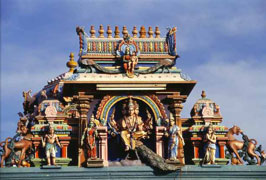History
Temples of South India
Temples of South

India’s contribution to the spiritual sphere of modern world is unique. From Vedic aga,all that is pure and sublime in Nature’s creation have been objects of worship for the indian. Our history of ancient tradition and culture is interwoven in temple worship and pilgrimage. The lofty Himalayas, the sacred Ganga, the holy Cauvery, the crystal-like Tungabhadra have all been his cherished pilgrim spots.
In South India, temple worship has been a glorious tradition. Over the years, there have been many schools of temple-building – the Dravidian, Chalukya, Chola, Pallava, Pandya and the Hoysala. The art made its transition from temporary structures of wood and mortar to more enduring edifices. The temples were constructed according to Agama and Shilpa shastras. These temples were the seat of learning and hub of social and cultural activities.
In this, the Pallava rulers of the 7th century were said to be the pioneers. In Tamil Nadu, the temples of Kanchipuram, the shrines of Cholas in Thanjavur district (9th to 13th centuries) and those of Nayaks of Madurai are living monuments to their accomplishments. Today, in the state of Tamil Nadu alone, there are more than 10,000 temples. Of these, 1,800 are in Thanjavur district alone.
Karnataka’s tryst with temple art dates back to the 5th century AD. Aihole, Badami and Pattadakkal are the earliest works of the Chalukyas. Hampi, the capital of the Vijayanagar dynasty, is acclaimed for its brilliant temple designs. The state, as a whole, has a great tradition of holy places, palaces and pageantry.
Andhra Pradesh, endowed with a rich Coromandel Coast, had a mixed culture of the Cholas, Chalukyas and Gangas. The state has some of the earliest relics of temple architecture of the Buddhists and Jains. There is a discernible influence of Oriyan art as well. The temples of Sri Kalahasti, Srisailam, Simhachalam, Amaravati etc are some of the oldest works of the divine art.
Kerala is a land of rituals and festivals. According to legend, it was created by the blow of sage Parasurama’s axe. The history of temples in this state dates back to the 9th century. Among the main dynasties who ruled here were the Cheras, Mushikas and the Venad Kings. Thanks to the dense forests here, the temple structures are primarily of wood. These temples display the pristine purity of the ancient tradition even to this day. With the advent of adi Sankara, Ramanuja, Madhwacharya, the Nayanmars and Always, the Bhakti cult got a major boost. They spread their divine message by traversing through the numerous shrines singing in praise of the Almighty. Saivism and Vaishnavism florished to great heights. No wonder then that today we have the sacred legacy of 108 Tirupatis, Navagraha Sthalas, the Arupadai Veedus, Ashta Veerattanams etc. ever sought after by pilgrims.
This pilgrim-friendly guide focusses on the many important holy shrines that dot these southern states, providing in a nutshell the significance of each of these places and the interesting legends associated with them. In order to minimise the travel hardships of the pilgrims, a sincere attempt has been made to arrange places according to their proximity to important towns and cities.
Gavi Gangadhareswara temple: Sage Gautama had worshipped Lord Siva in this cave temple. The sanctum facing south, which is a rare feature, is flanked by the shrines of Devi Parvati and Durga. The images of Shanmukha and Ayyappa and those of Chandra, Surya and Bhairava are exquisitely carved. In the front yard; there are stone monoliths of sun and moon discs.
On Makara Sankranti evening, the sun's rays pass through the horns of the Nandi briefly to fall on the Lingam.
Bull temple: In Kannada, Basava means bull, which gives the name Basavanagudi to the locality. The temple has a giant bull (4.6 metres tall), carved out of a single boulder. It is a sculptural masterpiece. The annual Groundnut Fair is held here during Nov-Dec. Dodda Ganapati, a magnificent image of the Lord, is enshrined adjacent to the Bull temple.
Devagiri Varaprada Sri Venkateshwara temple: Suburban Banashankari II Stage is identified with this famous Balaji temple. An attractive gopuram beckons the visitor. The image of Lord Balaji appears to be a replica of the idol at Tirumala. Vinayaka and Alamelumanga Thayar are enshrined on either side of the sanctum. Navagrahas and Hanuman have separate shrines.
Vaikunta Ekadasi and Saturdays attract a large number of devotees. Thirukalyana Seva is an important offering.
Banashankari temple: The Devi shrine at the southern limits of Bangalore is much sought after by devotees. The Goddess is seated on a Lion. Hundreds of people congregate here for the Raahukaala puja on Sundays, Tuesdays and Fridays.
Srinivasa Prasanna Venkataramanaswamy temple: The Wodeyar rulers built this Vishnu temple nearly 300 years ago. It is situated near Tipu Sultan's Summer Palace.
Sri Dharmarayaswamy temple: It is a Dravidian-style shrine situated at Nagarathpet. There are three towers. In the sanctum, Dharmaraya, Krishna, Arjuna, Draupadi and Bhima are worshipped. Karaga festival is celebrated during March-April. Karaga, an earthen pot symbolising Shakti, is taken out in a spectacular procession to the Sampangi Tank on the night of Chaitra Poornima.
Udupi is one of the seven Mokshapuris highly revered in the land of Parasurama. The sacred idol of Lord Balagopala installed by Sri Madhwacharya (1238-1317 AD) was originally worshipped by Devi Rukmini in Dwaraka in the Dwapara Yuga.
The advent of Lord Krishna to this divine land is dramatic. Long ago, once when Sri Madhwa was meditating near the Malpe Beach (5 km from Udupi), he saw a ship in danger due to severe storm. He saved the ship by his yogic power. As the Swamiji knew beforehand that the ship carried the idols of Krishna and Balarama, he accepted Gopi Chandana pieces that the ship's captain offered. He installed the Balarama idol in Vada Pandeshwara village near the shores and the Krishna idol at Udupi near the Chandramouleeswara shrine.



